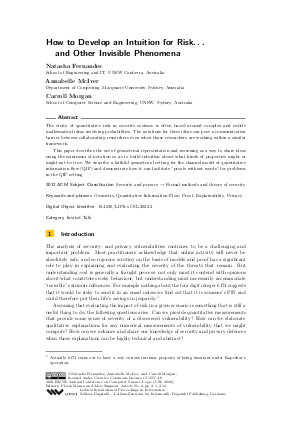How to Develop an Intuition for Risk... and Other Invisible Phenomena (Invited Talk)
Authors Natasha Fernandes, Annabelle McIver, Carroll Morgan
-
Part of:
Volume:
30th EACSL Annual Conference on Computer Science Logic (CSL 2022)
Part of: Series: Leibniz International Proceedings in Informatics (LIPIcs)
Part of: Conference: Computer Science Logic (CSL) - License:
 Creative Commons Attribution 4.0 International license
Creative Commons Attribution 4.0 International license
- Publication Date: 2022-01-27
File

PDF
LIPIcs.CSL.2022.2.pdf
- Filesize: 1.84 MB
- 14 pages
Document Identifiers
Subject Classification
ACM Subject Classification
- Security and privacy → Formal methods and theory of security
Keywords
- Geometry
- Quantitative Information Flow
- Proof
- Explainability
- Privacy
Metrics
- Access Statistics
-
Total Accesses (updated on a weekly basis)
0Document
0Metadata
Abstract
The study of quantitative risk in security systems is often based around complex and subtle mathematical ideas involving probabilities. The notations for these ideas can pose a communication barrier between collaborating researchers even when those researchers are working within a similar framework. This paper describes the use of geometrical representation and reasoning as a way to share ideas using the minimum of notation so as to build intuition about what kinds of properties might or might not be true. We describe a faithful geometrical setting for the channel model of quantitative information flow (QIF) and demonstrate how it can facilitate "proofs without words" for problems in the QIF setting.
Cite As Get BibTex
Natasha Fernandes, Annabelle McIver, and Carroll Morgan. How to Develop an Intuition for Risk... and Other Invisible Phenomena (Invited Talk). In 30th EACSL Annual Conference on Computer Science Logic (CSL 2022). Leibniz International Proceedings in Informatics (LIPIcs), Volume 216, pp. 2:1-2:14, Schloss Dagstuhl – Leibniz-Zentrum für Informatik (2022)
https://doi.org/10.4230/LIPIcs.CSL.2022.2
BibTex
@InProceedings{fernandes_et_al:LIPIcs.CSL.2022.2,
author = {Fernandes, Natasha and McIver, Annabelle and Morgan, Carroll},
title = {{How to Develop an Intuition for Risk... and Other Invisible Phenomena}},
booktitle = {30th EACSL Annual Conference on Computer Science Logic (CSL 2022)},
pages = {2:1--2:14},
series = {Leibniz International Proceedings in Informatics (LIPIcs)},
ISBN = {978-3-95977-218-1},
ISSN = {1868-8969},
year = {2022},
volume = {216},
editor = {Manea, Florin and Simpson, Alex},
publisher = {Schloss Dagstuhl -- Leibniz-Zentrum f{\"u}r Informatik},
address = {Dagstuhl, Germany},
URL = {https://drops.dagstuhl.de/entities/document/10.4230/LIPIcs.CSL.2022.2},
URN = {urn:nbn:de:0030-drops-157227},
doi = {10.4230/LIPIcs.CSL.2022.2},
annote = {Keywords: Geometry, Quantitative Information Flow, Proof, Explainability, Privacy}
}
Author Details
References
-
M. S. Alvim, K. Chatzikokolakis, A.K. McIver, C.C. Morgan, C. Palamidessi, and G. Smith. The Science of Quantitative Information Flow. Information Security and Cryptography. Springer International Publishing, 2020.

-
Mário S. Alvim, Kostas Chatzikokolakis, Catuscia Palamidessi, and Geoffrey Smith. Measuring information leakage using generalized gain functions. In Proc. 25th IEEE Computer Security Foundations Symposium (CSF 2012), pages 265-279, June 2012.

-
Oliver Byrne, Bruce Rogers, and Euclid. The first six books of the elements of Euclid: in which coloured diagrams and symbols are used instead of letters for the greater ease of learners / by Oliver Byrne. William Pickering London, 1847.

-
David Clark, Sebastian Hunt, and Pasquale Malacaria. Quantitative analysis of the leakage of confidential data. Electr. Notes Theor. Comput. Sci., 59(3):238-251, 2001.

-
Michael R. Clarkson, Andrew C. Myers, and Fred B. Schneider. Belief in information flow. In 18th IEEE Computer Security Foundations Workshop, (CSFW-18 2005), 20-22 June 2005, Aix-en-Provence, France, pages 31-45, 2005.

-
J. Conway and A. Soifer. Can n²+1 unit equilateral trianges cover an equilateral triangle of side > n, say n+ε? The American Mathematical Monthly, 18(143), 2005.

-
Cynthia Dwork. Differential privacy. In Proc. 33rd International Colloquium on Automata, Languages, and Programming (ICALP 2006), pages 1-12, 2006.

-
Natasha Fernandes, Annabelle McIver, and Carroll Morgan. The laplace mechanism has optimal utility for differential privacy over continuous queries. In 36th Annual ACM/IEEE Symposium on Logic in Computer Science, LICS 2021, Rome, Italy, June 29 - July 2, 2021, pages 1-12. IEEE, 2021.

-
Jaisook Landauer and Timothy Redmond. A lattice of information. In Proc. 6th IEEE Computer Security Foundations Workshop (CSFW'93), pages 65-70, June 1993.

- Annabelle McIver, Carroll Morgan, Geoffrey Smith, Barbara Espinoza, and Larissa Meinicke. Abstract channels and their robust information-leakage ordering. In Martín Abadi and Steve Kremer, editors, Principles of Security and Trust - Third International Conference, POST 2014, Held as Part of the European Joint Conferences on Theory and Practice of Software, ETAPS 2014, Grenoble, France, April 5-13, 2014, Proceedings, volume 8414 of Lecture Notes in Computer Science, pages 83-102. Springer, 2014. URL: https://doi.org/10.1007/978-3-642-54792-8_5.
-
Roger Nelsen. Proofs Without Words: Exercises in Visual Thinking, volume 1. MAA Press, 1993.

-
C.E. Shannon. A mathematical theory of communication. Bell System Technical Journal, 27:379-423, 623-656, 1948.

-
Geoffrey Smith. On the foundations of quantitative information flow. In Luca de Alfaro, editor, Proc. 12th International Conference on Foundations of Software Science and Computational Structures (FoSSaCS '09), volume 5504 of Lecture Notes in Computer Science, pages 288-302, 2009.

